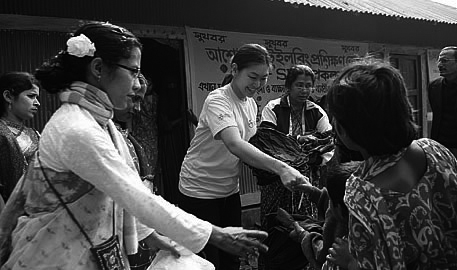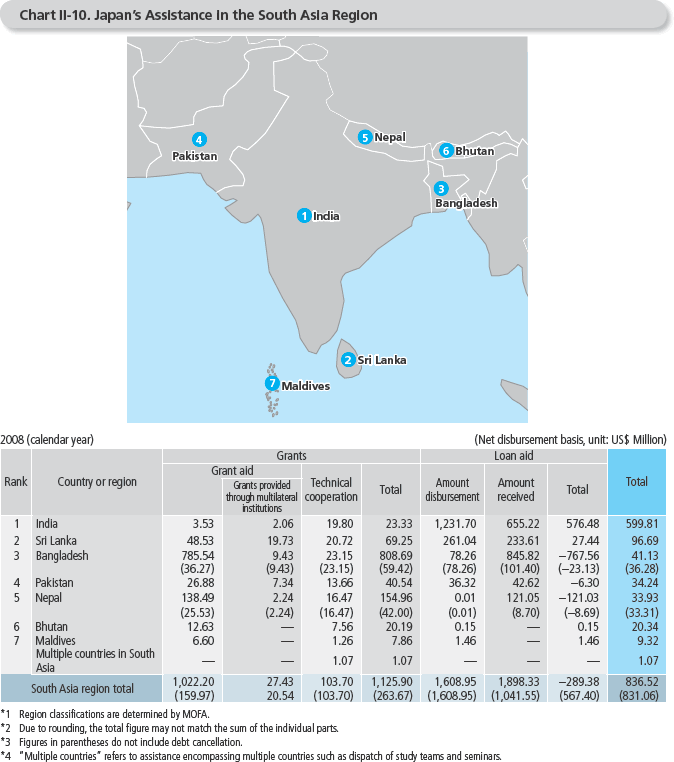Japan's Official Development Assistance White Paper 2009
2. South Asia
•Approximately US$836.52 million (approximately US$2,734.85 million)
•Approximately 12.1% of total bilateral aid (approximately 18.4%)
The South Asian region includes countries that have high rates of economic growth and gigantic economic potential, particularly India, the world's largest democracy. Accordingly, this region's position in the international community is becoming more prominent. South Asia is located on the marine transport route linking Asia with the Middle East, and thus is strategically important to Japan. It is also an important region from the viewpoint of dealing with global environmental issues. In addition, the region is of great concern to the international community, including Japan, due to the issue of weapons of mass destruction possessed by India and Pakistan and of its role in international undertakings against terrorism and extremism.
However, the South Asian region still faces a large number of issues to be addressed, including a serious lack of basic infrastructure, such as roads, railroads, and ports, growing populations, low school enrollment ratio in primary education, undeveloped water and sanitation facilities along with inadequate healthcare and medical facilities, insufficient maternal and child healthcare, and a lack of countermeasures against infectious diseases and the rule of law. Poverty reduction is a particularly serious issue, where 500 million of the region's 1.5 billion population is living in poverty, making it one of the world's poorest regions. South Asia is the second most important region behind Africa in aim to achieve the Millennium Development Goals (MDGs). (Note 40)
Notes:
(40) According to the Millennium Development Goals Report 2009, the ratio of people in the South Asian region that live on approximately US$1 a day is 39% (2005). This is the second highest figure behind Sub-Saharan Africa.
<Japan's Efforts>
For harnessing the economic potential of South Asia and alleviating the widening disparities between the rich and poor, Japan provides assistance to South Asia centered on developing socioeconomic infrastructure. Particularly in its relationship with India, a central presence in the region, Japan promotes cooperation in a wide range of fields based on the Strategic and Global Partnership, an alliance sharing basic values. These include politics and security, economic cooperation, and academic exchanges. India is the largest recipient country for Japanese ODA loans, where Japan advances the development of economic infrastructure, including power and transport, as well as the development of the social sector aimed at reducing poverty by improving the rural environment.
In regards to Pakistan, the Friends of Democratic Pakistan Ministerial Meeting and Pakistan Donors Conference were held in Tokyo in April 2009. At the Pakistan Donors Conference, assistance totaling over US$5 billion from participating nations and organizations was announced for Pakistan to employ terrorism countermeasures and economic reform, whereupon Japan also announced that it would provide up to US$1 billion in aid to Pakistan.
In May 2009 in Sri Lanka, the more than 25-year battle between government forces and the Liberation Tigers of Tamil Eelam (LTTE) came to an end. Sri Lankan President Mahinda Rajapaksa announced that he would work to produce a political solution to ethnic reconciliation and work to develop the country. Japan provides aid to Sri Lanka while paying consideration to regional and ethnic balance in order to assist in the promotion of the consolidation of peace and socioeconomic development.
In the South Asian Region, efforts aimed at aid coordination in the various countries are moving forward. In 2005, for instance, Japan started the "Joint Strategy for Bangladesh along with the World Bank, ADB and the UK's Department for International Development (DFID), all of which are working toward collaboration in assistance under this strategy. In addition, the major traditional donor countries and agencies are forming a "Joint Assistance Strategy" in order to promote coordination and collaboration for the assistance of the poverty reduction strategy paper enacted by the government of Bangladesh effectively.

Education support and mental care project in Bangladesh (Photo: Kokkyo naki Kodomotachi NGO)

Micro, Small and Medium Enterprises Energy Saving Project (India)
Environmental improvements in India are important in order to realize sustainable economic development in the country, as well as from the perspective of global-scale climate change countermeasures. In consideration of these circumstances, Japan provides the necessary mid- to long-term funding for energy conservation undertakings via ¥30 billion in ODA loans extended to micro, small, and medium enterprises in India. By utilizing a network of institutions including the issuer of the loan—the Small Industries Development Bank of India—as well as other intermediate financial institutions, Japan provides wide-spanning energy-saving assistance throughout all of India while also aiding the enhancement of financial screening skills of these financial institutions.
Solid Waste Management Project in Dhaka City (technical cooperation project) and the Programme for Improvement of Solid Waste Management in Dhaka City toward the Low Carbon Society (grant aid) (Bangladesh)
Dhaka City, the capital of Bangladesh with a population of over 12 million people, has a low collection rate for household and other garbage and a large amount of garbage is left uncollected around the city. In addition, the amounts of garbage put out for collection continues to increase, creating serious sanitation and environmental problems. Through technical cooperation, Japan assists in the spread of garbage collection activities via resident participation, the creation of disposal sites that elicit little environmental burden, and the structural enhancement of Dhaka City Hall, which overseas waste countermeasures. As a result, voluntary collection activities by residents are advancing and the environment of disposal sites has been dramatically improved. In addition, grant aid was used to donate nearly 100 waste collection vehicles. Through the provision of collection vehicles that emit low amounts of CO2, Japan has been able to simultaneously address greenhouse gas reduction measures as well.
